Any links to online stores should be assumed to be affiliates. The company or PR agency provides all or most review samples. They have no control over my content, and I provide my honest opinion.
There have already been numerous leaks about the new flagship chipsets from MediaTek, Qualcomm and Samsung, enough that I was able to do a comparison post of the latest flagship chipsets.
Yesterday, MediaTek officially announced the Dimensity 9000. Obviously, all the leaks got the name wrong, and the frequencies have now been confirmed. But we now also know a bit more about the other specs.
In recent news, it appears Qualcomm will also be using a different name than expected, the new chipset is believed to be called the Snapdragon 8 Gen1, rather than the Snapdragon 898.
With the full specification of the Dimensity 9000 revealed, it is clear that MediaTek has its strongest chipset in years. I doubt it will be better in performance compared to Qualcomm, but the gap should be considerably narrowed, and MediaTek will likely continue to be the value option for 2022. It is quite feasible that MediaTek Dimensity 9000 phones in 2022 will have the best cost/performance ratio on the market.
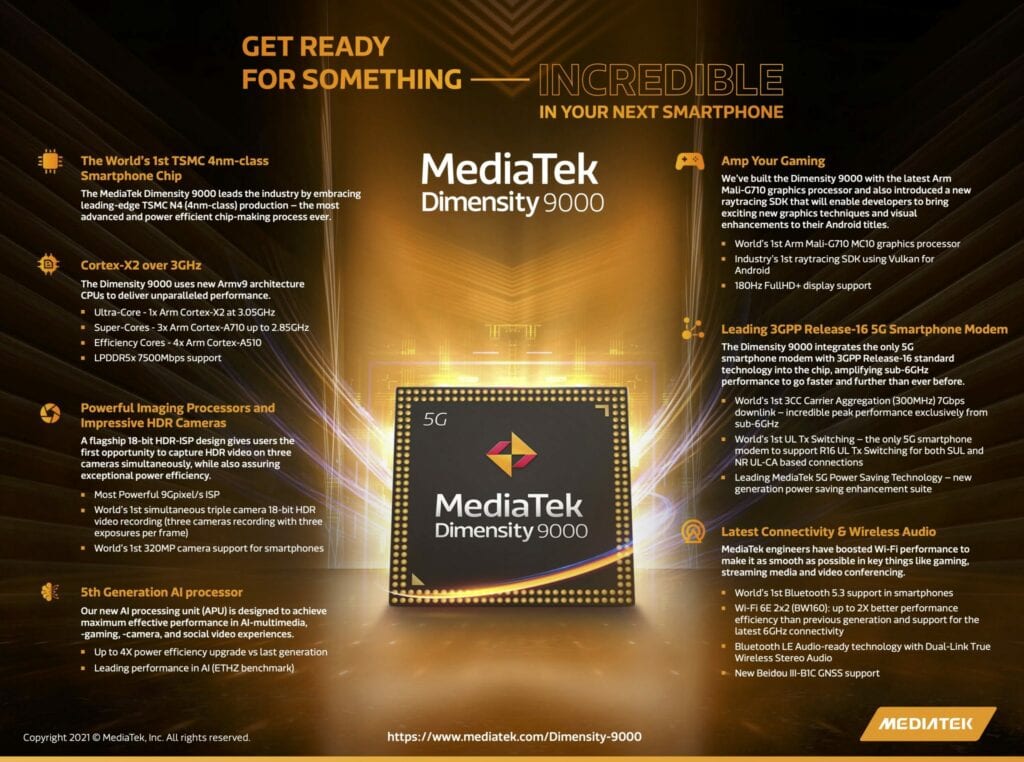
Fabrication Process / CPU / GPU
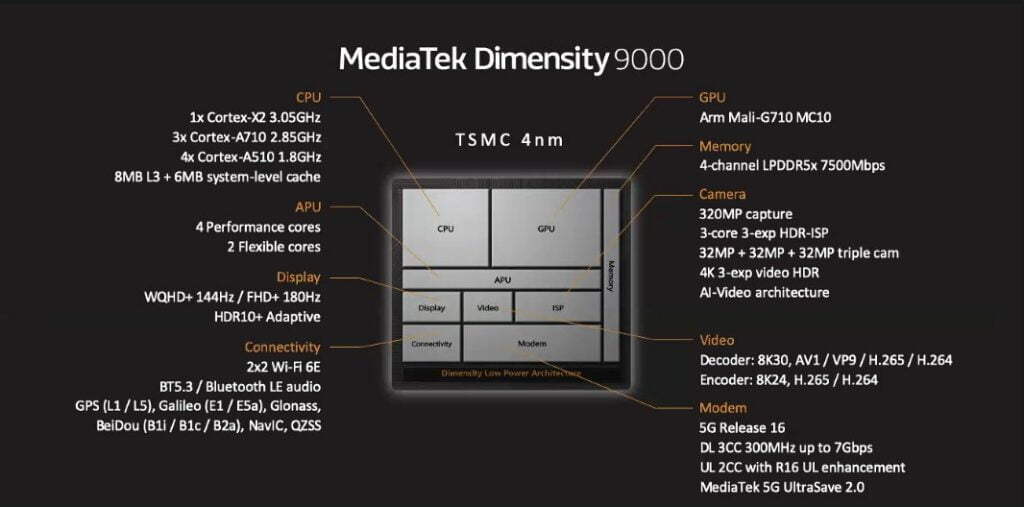
I have already covered the core specs of the chipset in my comparison post, but to go over them again:
MediaTek will be the only company using the TSMC N4 fabrication process, and TSMC has historically been the best chipset fabricator. It is quite possible the battery, and thermal throttling issues the SD888 and Exynos 2100 had were at least partly due to the Samsung fabrication process. This could give MediaTek a significant advantage.
MediaTek has confirmed the CPU frequencies, and they are fractionally higher than the leaked Qualcomm specification with:
- 1x Cortex-X2 @ 3.05GHz 1x1024KB pL2
- 3x Cortex-A710 @ 2.85GHz 3x512KB pL2
- 4x Cortex-A510 @ 1.80GHz 4x256KB pL2
Mediatek has revealed some extra information about the CPU. MediaTek has claimed that there is a +35% performance increase over current-generation Android Flagship chips (likely SD888). For me, more importantly, is a 37% improvement in efficiency. Technically this will put the peak power at about the same as the X1, however, with the chipset being faster, it gets jobs done quicker and therefore reduces battery usage.
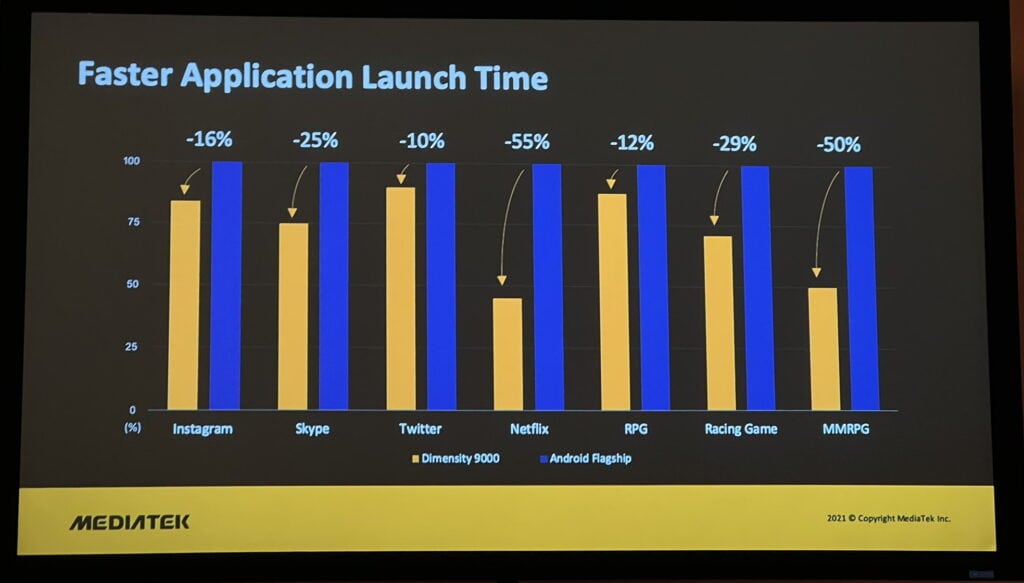
While Mediatek is using the same Cortex-A510 cores as Qualcomm and Samsung, it looks like they are going their own route with how things work. Arm has designed the Cortex-A510 to be able to share a SIMD/FP pipeline and L2 cache. MediaTek has designed the chipset to work like previous chipsets with its own dedicated cache. How much of a difference this makes remains to be seen.
We already knew about the Arm Mali-G710MP10 GPU, but this is now confirmed as running at 850MHz. The GPU is likely to be one of the biggest factors separating the chipsets this year. MediaTek is the only company using Arm Mali (though Tensor 2 may use it). Qualcomm will continue using Adreno while Samsung shifts to AMD.
ISP and APU/NPU
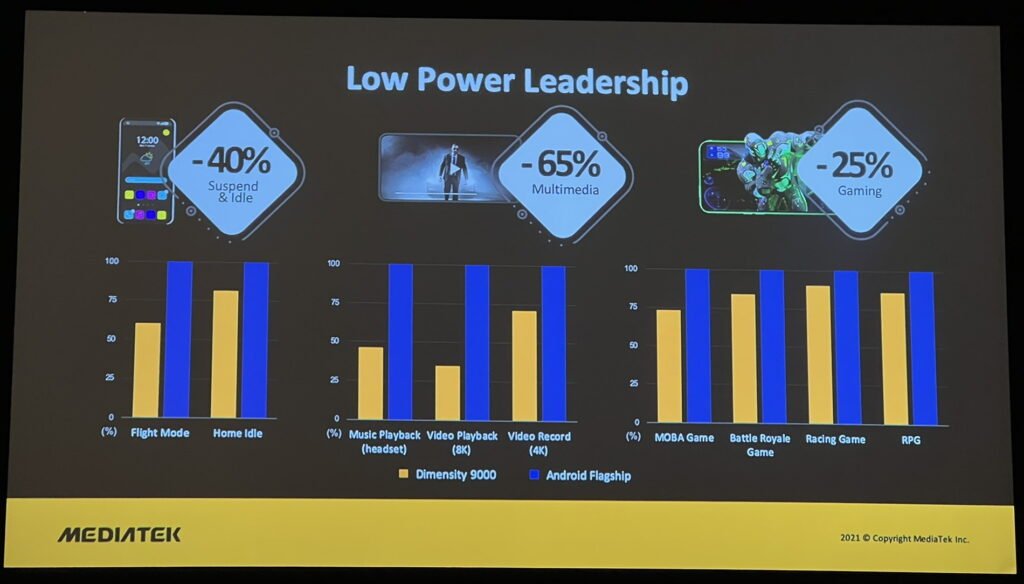
In recent years, companies have shifted their focus from raw processing power to image processing and artificial intelligence. The Google Tensor is a good example, showing the shift to be more AI focussed.
The new 5th Generation AI processing unit (APU) has a four-fold improvement from both the performance and power efficiency of the previous Dimensity 1200.
Mediatek showed an ETHZ Ai Benchmark revealing the new chipset is 16% ahead of the Google Pixel 6 with its Google Tensor chipset. Google has made a big jump in AI performance, but the underlying chipset is essentially a 2021 flagship chipset, so it is inevitable next years chips will be better.
Similarly, the image signal processor (ISP) has seen a significant improvement.
This is now a triple ISP that can work concurrently, allowing up to 9 gigapixels/s of throughput. The ISP claims to be the worlds first to support 320MP, and Mediatek states they are working with a vendor to bring this functionality to market.
The camera can support 32+32+32MP concurrent sensor operation.
Mediatek were the first to implement AV1 decoding, this now improves to 8K AV1 video decoding, but there is still no AV1 encoding.
The chipset can drive displays with WQHD+ to 144Hz, or FHD+ up to 180Hz with full HDR+ Adaptive (10-bit).
Connectivity
The new chipset is also the worlds first to have Bluetooth 5.3. It will also support Wi-Fi 6E for 6GHz band support and 160MHz channel bandwidth. Qualcomm already supported Wi-Fi 6E but few brands implemented it.
Modem
As you’d expect, there are several modem upgrades with up to 300MHz of 5G spectrum aggregated over three carriers allowing up to 7Gbps download
MediaTek Dimensity 9000 Specifications Compared
| Qualcomm Snapdragon 8 Gen 1 | Mediatek Dimensity 9000 | Samsung Exynos 2200 | |
|---|---|---|---|
| Fabrication Process | 4nm Samsung | 4nm TSMC | 4nm Samsung |
| CPU | 1 x Arm Cortex-X2 @ 3.0 GHz with 1024KB pL2 3 x ArmCortex-A710 @ 2.5 GHz with 3x512KB pL2 4 x Arm Cortex-A510 @ 1.8GHz with 2x unknown sL2 | 1 x Arm Cortex-X2 @ 3.05 GHz 3 x ArmCortex-A710 @ 2.85 GHz 4 x Arm Cortex-A510 @ 1.8 GHz | 1 x Arm Cortex-X2 @ 3.0 GHz 3 x ArmCortex-A710 @ 2.5 GHz 4 x Arm Cortex-A510 @ 1.8 GHz |
| GPU | Adreno next-gen (730) | ARM Mali-G710 MC10 | AMD RDNA 2 GPU |
| Memory | 4x 16-bit 3200MHz LPDDR5 / 51.2GB/s 4MB System Cache | 4x 16-bit 3200MHz LPDDR5 / 51.2GB/s 3750MHz LPDDR5X / 60.0GB/s = 7500Mbps support 6MB System Cache | TBC |
| ISP | Triple 18-bit Spectra ISP 1x 200MP or 108MP with ZSL 64+36MP with ZSL 3x 36MP with ZSL 8K HDR video & 64MP burst capture | Imagiq790 New-gen Triple 18-bit ISP 9GPix/s processing throughput Single Sensor up to 320MP Triple Sensor 32+32+32MP | TBC |
| NPU | Hexagon | 5th Gen 4+2 core APU | TBC |
| Media | 8K30 / 4K120 10-bit H.265 Dolby Vision, HDR10+, HDR10, HLG 720p960 infinite recording No AV1 decoding | 8K30 & 4K120 encode & 8K60 decode H.265/HEVC, H.264, VP9 8K30 AV1 Decode | TBC |
| Connectivity | TBC | Bluetooth 5.3 Wi-Fi 6E | TBC |
| Modem | Integrated X65 5G NR Sub-6 + mmWave DL = 10000 Mbps UL = 3000 Mbps | LTE Category 24/18 5G NR Sub-6 | TBC |
Conclusion
The Mediatek Dimensity 9000 is certainly an exciting chipset, and I hope we see devices with it launched in the UK a bit earlier in the year than the Dimensity 1200. The OnePlus Nord 2 has been one of my favourite phones of the year, it offers superb performance for the money. I hope that Mediatek will continue this trend.
Many of the worlds first statements that came out yesterday are purely because Mediatek were the first to hold their announcement, so they are relatively meaningless marketing claims.
Qualcomm will hold their Snapdragon Summit starting on the 30th of November. This is when we will see what the competition is really like.
I am James, a UK-based tech enthusiast and the Editor and Owner of Mighty Gadget, which I’ve proudly run since 2007. Passionate about all things technology, my expertise spans from computers and networking to mobile, wearables, and smart home devices.
As a fitness fanatic who loves running and cycling, I also have a keen interest in fitness-related technology, and I take every opportunity to cover this niche on my blog. My diverse interests allow me to bring a unique perspective to tech blogging, merging lifestyle, fitness, and the latest tech trends.
In my academic pursuits, I earned a BSc in Information Systems Design from UCLAN, before advancing my learning with a Master’s Degree in Computing. This advanced study also included Cisco CCNA accreditation, further demonstrating my commitment to understanding and staying ahead of the technology curve.
I’m proud to share that Vuelio has consistently ranked Mighty Gadget as one of the top technology blogs in the UK. With my dedication to technology and drive to share my insights, I aim to continue providing my readers with engaging and informative content.

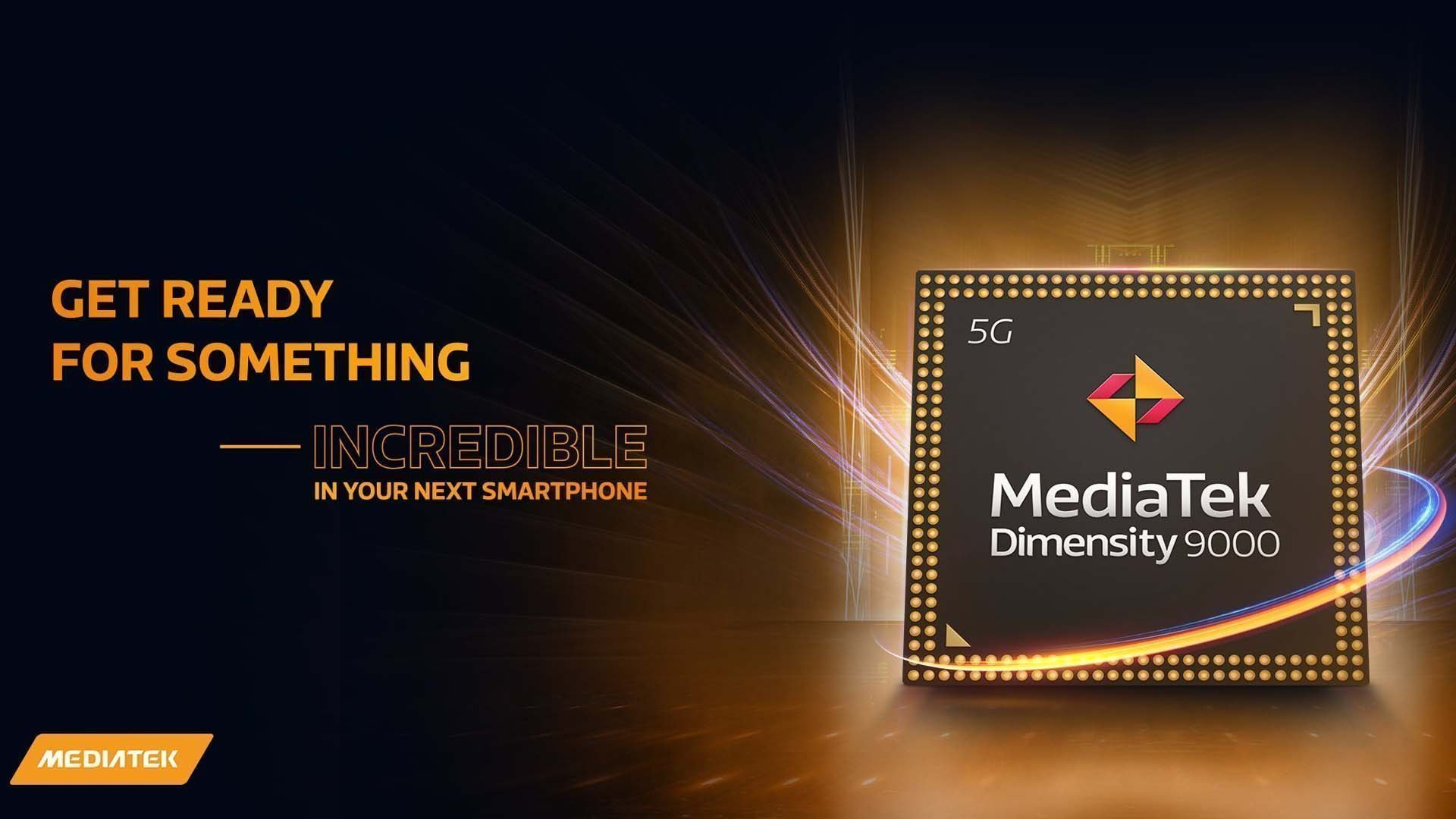
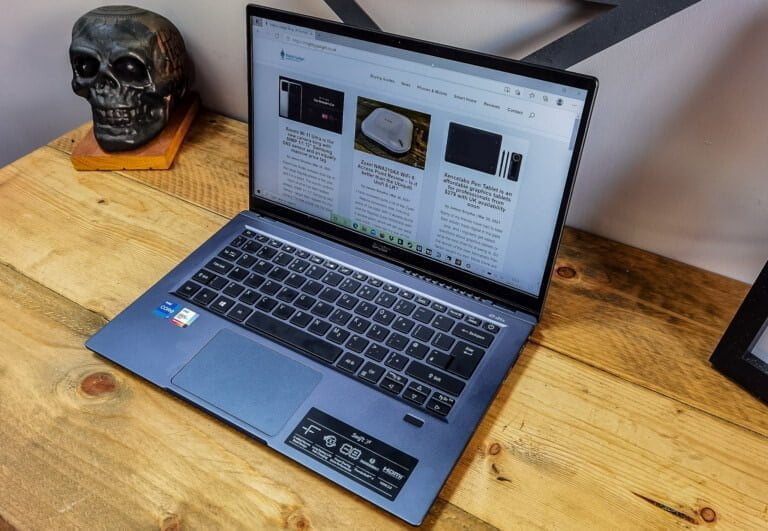
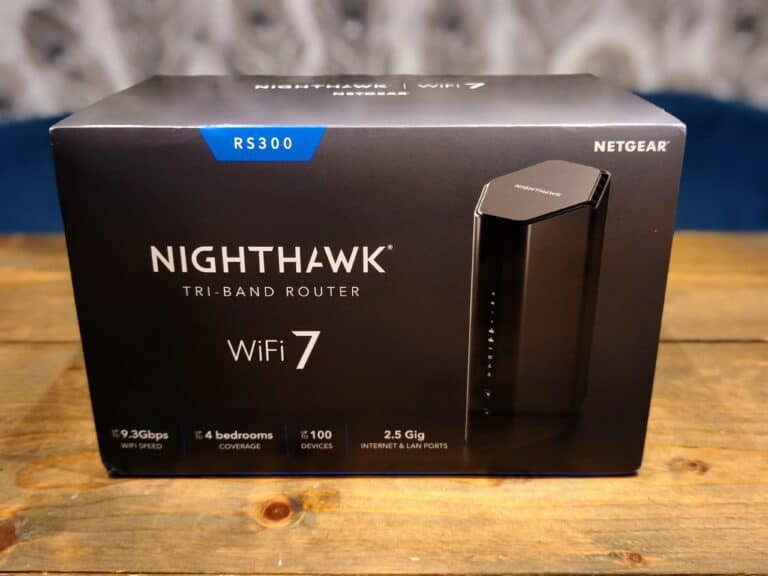

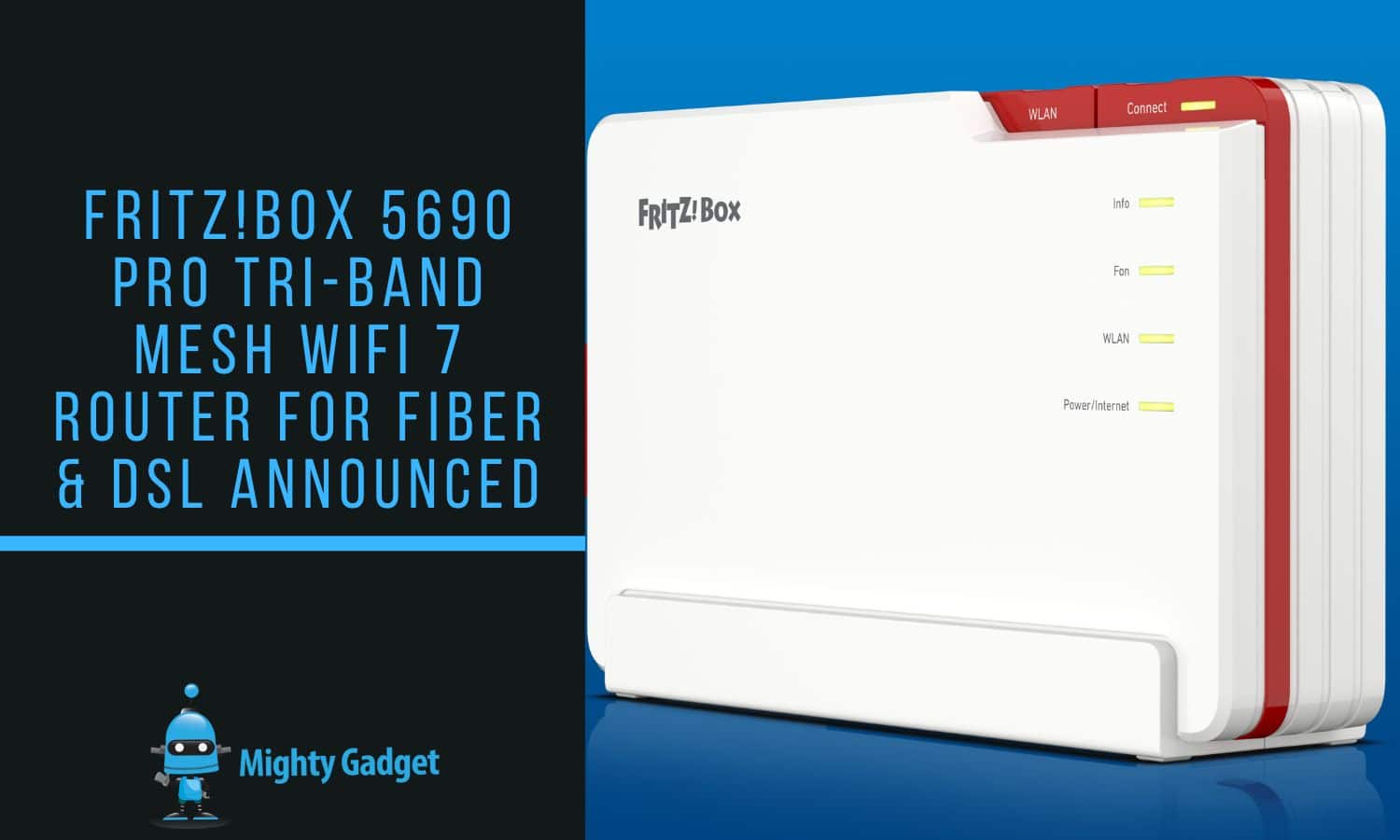


A crazy 5g processor by mediatek. It has everything.
Mediatek with a great 5g processor that has great power. 3.05ghz clock speed is amazing.